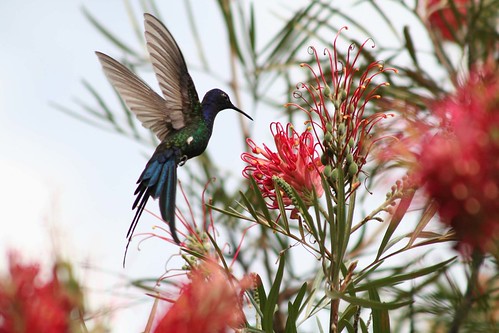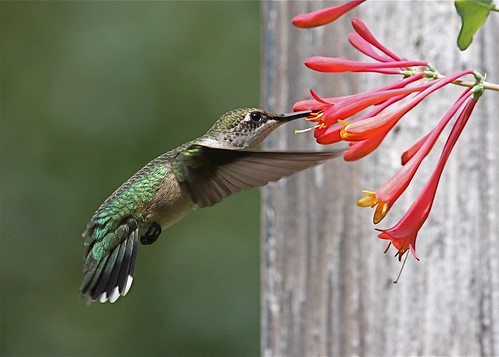Beija-flor (Eupetomena macroura) – Swallow-tailed Hummingbid 2 592 – 2 by Flávio Cruvinel Brandão
My heart leaps up when I behold
A rainbow in the skyby William Wordsworth
So does my heart leap up when I behold an animal, bird or beneficial insect that has returned or come for the first time to my garden.
For example, I have a number of birds nests but only one seems to have a resident each year. I know that size of opening is a major factor that determines which bird will use a certain bird house. But I also read that birds seem to like pretty bird houses and this birdhouse that has had birds build nests every year is the prettiest birdhouse on my property. I had also been told that bird houses should be cleaned out yearly because birds can have lice and that the inhabitants need it clean. This bird house was filled so high with twigs that I couldn’t believe another bird could fit into it. So last fall I cleaned out all the all old twigs only to be entertained by this year’s birds filling the nest back up with twigs piled so high. I didn’t think anything could fit in besides the twigs but I hope they know what they are doing and lay eggs on that pile.  Check out this video clip.
I have lots of birds on this property because I have lots of shrubs for them to hide or build nests and have a stream for them to drink water. I plant flowers that I believe will encourage birds, butterflies and good insects. My soil has been amended so that I have lots of healthy worms. Robins love the worms. I have yellow flowers for the goldfinch so it is a special delight when they return. One has been tap-tap -tapping on the window.
And of course, I do everything I can to encourage hummingbirds. This year I added a honeysuckle that they love Lonicera sempervirens – coral red honeysuckle. Hummingbirds are always such a delight to see in the garden. ( I also have hummingbird moths. See here. )
I have so many birds singing at daybreak that I don’t need a rooster to wake me up each morning.
I have been spraying Liquid Fence on the plants so that deer won’t eat the ones I planted. My heart leaps up even when I see deer but there is enough wild greens for them to eat without eating dessert all the time – like my hostas are to them. This year I have so many hostas in bloom that I hope all the black swallowtail butterflies will see them and return. I have been counting those swallowtail butterflies that I see but there haven’t been that many. I always had a lot of hosta flowers before deer became so prevalent and decimated these flowers. Liquid Fence has been my garden’s savior.
As I sit and write TheGardenLady post, I am often entertained by a bird resting on a branch outside in my backyard. I especially love to see the colorful ones, like the cardinals that always build nests in shrubs around the house.
I almost stopped using my front door because a delicate paper wasp nest was built. I am leaving it up for now unless someone gets stung. As much as I believe this is a beneficial insect, at the end of the year, sadly, I will have it removed.



